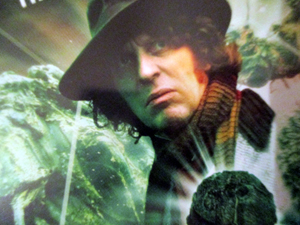The Seeds of Doom
“Yes. The plants must win. It will be a new world, silent and beautiful.” – Harrison Chase
Like the previous stories, this one is initially based on a classic horror film; the first two episodes set in Antarctica are virtually lifted straight from The Thing and retain the signature claustrophobia of that work. However, this story does not have the feel of ancient gothic horror found throughout most of this season but rather much more that of a contemporary thriller. Harrison Chase is the quintessential movie millionaire madman—almost cartoonish in his villainy and ability to buy loyalty to a ridiculous degree—while the corruption and thuggery and compromises shown around him are quite hard-edged and realistic. Because of some of those elements, the show at times feels very different than a typical Doctor Who episode. I often have a dismissive view of it for that reason, but the more I watch it the more I’m struck by how well-written many aspects of the script are–from characters and the examinations of their motivations to surprise developments to tense situations.
Throughout the story, the Doctor has a very tetchy and noticeably irritated tone. (You could attribute this to his knowledge and worry over what he knows the Krynoid may do to Earth.) He seems to almost be above wasting his time even talking to people which allows us to see how much Sarah has become his mouthpiece—sounding exactly like the Doctor as she tries to coax Moberley or tears into the minister for his lack of action. The Doctor does get in some rather funny anti-stuffy bureaucrat lines. I’d also totally forgotten that he and Sarah are called into the whole affair by UNIT because none of our known UNIT characters ever appear. (How many times now has the Brigadier been off in Geneva?) Indeed, you’d almost have preferred they not use the UNIT name at all rather than have a bunch of nameless soldiers adding nothing to the story.
There are a number of bits to the story that I especially like such as when the seemingly throwaway character of eccentric Amelia Ducat shows up and interrupts Chase’s experiment. When Sarah catches her and begs help, it seems like one of those unplanned fortuitous turns that will save the day for our heroes. It’s quite a nice surprise for it to turn out that she was secretly working on mission for Thackery to get to the Doctor and Sarah. (This would only have been better if it was UNIT who was involved and it had been the Brigadier’s idea.) Even though the effects are not that great, I like that they had the idea to have the Krynoid keep growing and growing to such a huge size and to have it controlling plants miles around. Chase’s second level of madness is also well done. It’s quite eerie to hear his insane whispers to himself lying on his back in the field or sitting in his green cathedral. I really like the additional line where the Doctor, initially thinking that Chase was reaching for help to be saved from death in the crusher, is astounded to realize that he was actually just trying to pull him in instead.
The only let-down is how the story is basically wrapped up by the rather obvious step of just blowing the thing up. Too bad the Brigadier wasn’t around to finally see that work! There’s also a very weird and unnecessary coda at the end with the Doctor and Sarah laughing about accidently ending back up in Antarctica.
Best (or worst) unsettling moments:
While Harrison Chases love for the plant world takes on a bit of fantastical edge, the grim deaths of the soldiers, Hargreaves, and many neighbors by strangling vines—and especially Scorby being dragged down into the water—are all quite realistic and scary. But the surprisingly cruel edge of humanity in this very adult story stands out too: Scorby’s schoolyard bullying of the Doctor as he’s about to kill him, Chase callously ignoring Keeler’s pleas for hospital, and the poor soldier being put through the grinder without much fanfare.
Regrets:
As I said, the story feels thinner for lack of any recognizable UNIT characters. I wish the effects of the Krynoid at its largest size could have been better realized as well.

